Direct Oral FXa Inhibitors Binding to Human Serum Albumin: Spectroscopic, Calorimetric, and Computational Studies
Abstract
:1. Introduction
2. Results and Discussion
2.1. Fluorescence Quenching of HSA
2.2. Thermodynamic Studies by Isothermal Titration Calorimetry
2.3. Molecular Dynamics Simulations
2.4. Possible Clinical Implications of the Binding of Direct FXa Inhibitors to HSA
3. Materials and Methods
3.1. Preparation of Stock Solutions
3.2. Materials and Equipment
3.2.1. Fluorescence Measurements
3.2.2. Isothermal Titration Calorimetry (ITC)
3.2.3. Computational Analysis
Supplementary Materials
Author Contributions
Funding
Institutional Review Board Statement
Informed Consent Statement
Data Availability Statement
Acknowledgments
Conflicts of Interest
References
- World Health Organization. Cardiovascular Diseases (CVDs). Available online: https://www.who.int/news-room/fact-sheets/detail/cardiovascular-diseases-(cvds) (accessed on 22 February 2022).
- Zacconi, F. FXa Direct Synthetic Inhibitors. In Anticoagulant Drugs; IntechOpen: London, UK, 2018. [Google Scholar] [CrossRef]
- Núñez-Navarro, N.; Santana, F.; Parra, L.; Zacconi, F. Surfing the Blood Coagulation Cascade: Insight into the Vital Factor Xa. Curr. Med. Chem. 2019, 26, 3175–3200. [Google Scholar] [CrossRef]
- Urquhart, L. Top companies and drugs by sales in 2020. Nat. Rev. Drug Discov. 2021, 20, 253. [Google Scholar] [CrossRef]
- McCarty, D.; Robinson, A. Factor Xa inhibitors: A novel therapeutic class for the treatment of nonvalvular atrial fibrillation. Ther. Adv. Cardiovasc. Dis. 2016, 10, 37–49. [Google Scholar] [CrossRef] [Green Version]
- Rodríguez, D.F.; Durán-Osorio, F.; Duarte, Y.; Olivares, P.; Moglie, Y.; Dua, K.; Zacconi, F.C. Green by Design: Convergent Synthesis, Computational Analyses, and Activity Evaluation of New FXa Inhibitors Bearing Peptide Triazole Linking Units. Pharmaceutics 2022, 14, 33. [Google Scholar] [CrossRef] [PubMed]
- Ruff, C.T.; Giugliano, R.P.; Braunwald, E.; Hoffman, E.B.; Deenadayalu, N.; Ezekowitz, M.D.; Camm, A.J.; Weitz, J.I.; Lewis, B.S.; Parkhomenko, A.; et al. Comparison of the efficacy and safety of new oral anticoagulants with warfarin in patients with atrial fibrillation: A meta-analysis of randomised trials. Lancet 2014, 383, 955–962. [Google Scholar] [CrossRef]
- Chai-Adisaksopha, C.; Hillis, C.; Isayama, T.; Lim, W.; Iorio, A.; Crowther, M. Mortality outcomes in patients receiving direct oral anticoagulants: A systematic review and meta-analysis of randomized controlled trials. J. Thromb. Haemost. 2015, 13, 2012–2020. [Google Scholar] [CrossRef] [Green Version]
- Dunois, C. Laboratory Monitoring of Direct Oral Anticoagulants (DOACs). Biomedicines 2021, 9, 445. [Google Scholar] [CrossRef] [PubMed]
- Ascenzi, P.; Fanali, G.; Fasano, M.; Pallottini, V.; Trezza, V. Clinical relevance of drug binding to plasma proteins. J. Mol. Struct. 2014, 1077, 4–13. [Google Scholar] [CrossRef]
- Roberti, R.; Iannone, L.F.; Palleria, C.; Curcio, A.; Rossi, M.; Sciacqua, A.; Armentaro, G.; Vero, A.; Manti, A.; Cassano, V.; et al. Direct Oral Anticoagulants: From Randomized Clinical Trials to Real-World Clinical Practice. Front. Pharmacol. 2021, 12, 684638. [Google Scholar] [CrossRef] [PubMed]
- Dias, C.; Moore, K.T.; Murphy, J.; Ariyawansa, J.; Smith, W.; Mills, R.M.; Weir, M.R. Pharmacokinetics, Pharmacodynamics, and Safety of Single-Dose Rivaroxaban in Chronic Hemodialysis. Am. J. Nephrol. 2016, 43, 229–236. [Google Scholar] [CrossRef]
- Wilson, J.-A.S.; Goralski, K.B.; Soroka, S.D.; Morrison, M.; Mossop, P.; Sleno, L.; Wang, Y.; Anderson, D.R. An evaluation of oral dabigatran etexilate pharmacokinetics and pharmacodynamics in hemodialysis. J. Clin. Pharmacol. 2014, 54, 901–909. [Google Scholar] [CrossRef]
- Ferri, N. Pharmacokinetics and Pharmacodynamics of DOAC. In Direct Oral Anticoagulants: From Pharmacology to Clinical Practice; Proietti, R., AlTurki, A., Ferri, N., Russo, V., Bunch, T.J., Eds.; Springer International Publishing: Cham, Switzerland, 2021; pp. 27–40. [Google Scholar]
- Roberge, G.; Wells, P.S. Apixaban anti-Xa level monitoring in treatment of acute upper extremity deep vein thrombosis for patient on chronic hemodialysis: A case report. Thromb. J. 2021, 19, 23. [Google Scholar] [CrossRef] [PubMed]
- Ascenzi, P.; Bocedi, A.; Notari, S.; Fanali, G.; Fesce, R.; Fasano, M. Allosteric Modulation of Drug Binding to Human Serum Albumin. Mini Rev. Med. Chem. 2006, 6, 483–489. [Google Scholar] [CrossRef] [PubMed]
- Kragh-Hansen, U. Human Serum Albumin: A Multifunctional Protein. In Albumin in Medicine: Pathological and Clinical Applications; Otagiri, M., Chuang, V.T.G., Eds.; Springer: Singapore, 2016; pp. 1–24. [Google Scholar]
- Margarson, M.P.; Soni, N. Serum albumin: Touchstone or totem? Anaesthesia 1998, 53, 789–803. [Google Scholar] [CrossRef]
- Ascenzi, P.; di Masi, A.; Fanali, G.; Fasano, M. Heme-based catalytic properties of human serum albumin. Cell Death Discov. 2015, 1, 15025. [Google Scholar] [CrossRef] [Green Version]
- Kragh-Hansen, U. Molecular and practical aspects of the enzymatic properties of human serum albumin and of albumin–ligand complexes. Biochim. Biophys. Acta Gen. Subj. 2013, 1830, 5535–5544. [Google Scholar] [CrossRef]
- Deb, P.K.; Al-Attraqchi, O.; Prasad, M.R.; Tekade, R.K. Chapter 11—Protein and Tissue Binding: Implication on Pharmacokinetic Parameters. In Dosage Form Design Considerations; Tekade, R.K., Ed.; Academic Press: Cambridge, MA, USA, 2018; pp. 371–399. [Google Scholar]
- Ràfols, C.; Amézqueta, S.; Fuguet, E.; Bosch, E. Molecular interactions between warfarin and human (HSA) or bovine (BSA) serum albumin evaluated by isothermal titration calorimetry (ITC), fluorescence spectrometry (FS) and frontal analysis capillary electrophoresis (FA/CE). J. Pharm. Biomed. Anal. 2018, 150, 452–459. [Google Scholar] [CrossRef] [PubMed] [Green Version]
- Narwal, M.; Kumar, D.; Mukherjee, T.K.; Bhattacharyya, R.; Banerjee, D. Molecular dynamics simulation as a tool for assessment of drug binding property of human serum albumin. Mol. Biol. Rep. 2018, 45, 1647–1652. [Google Scholar] [CrossRef]
- Ito, S.; Senoo, A.; Nagatoishi, S.; Ohue, M.; Yamamoto, M.; Tsumoto, K.; Wakui, N. Structural Basis for the Binding Mechanism of Human Serum Albumin Complexed with Cyclic Peptide Dalbavancin. J. Med. Chem. 2020, 63, 14045–14053. [Google Scholar] [CrossRef]
- Dargó, G.; Bajusz, D.; Simon, K.; Müller, J.; Balogh, G.T. Human Serum Albumin Binding in a Vial: A Novel UV-pH Titration Method To Assist Drug Design. J. Med. Chem. 2020, 63, 1763–1774. [Google Scholar] [CrossRef] [Green Version]
- Arques, S. Human serum albumin in cardiovascular diseases. Eur. J. Intern. Med. 2018, 52, 8–12. [Google Scholar] [CrossRef] [PubMed]
- Wojakowski, E.; Cheruvil, C.; Hassan, A.; Holsen, M.R.; Chen, L.; Rossi, M.; Wilcox, N.; Woodruff, A.E. Albumin and bleed risk in rivaroxaban treated patients. J. Thromb. Thrombolysis 2020, 50, 1004–1011. [Google Scholar] [CrossRef] [PubMed]
- Wang, Q.; Sun, Q.; Tang, P.; Tang, B.; He, J.; Ma, X.; Li, H. Determination of potential main sites of apixaban binding in human serum albumin by combined spectroscopic and docking investigations. RSC Adv. 2015, 5, 81696–81706. [Google Scholar] [CrossRef]
- De Simone, G.; Pasquadibisceglie, A.; di Masi, A.; Buzzelli, V.; Trezza, V.; Macari, G.; Polticelli, F.; Ascenzi, P. Binding of direct oral anticoagulants to the FA1 site of human serum albumin. J. Mol. Recognit. 2020, 34, e2877. [Google Scholar] [CrossRef] [PubMed]
- Wani, T.A.; AlRabiah, H.; Bakheit, A.H.; Kalam, M.A.; Zargar, S. Study of binding interaction of rivaroxaban with bovine serum albumin using multi-spectroscopic and molecular docking approach. Chem. Cent. J. 2017, 11, 134. [Google Scholar] [CrossRef] [Green Version]
- Robinson-Duggon, J.; McTiernan, C.D.; Muñoz, M.; Guerra, D.; Escobar Álvarez, E.; Andrade-Villalobos, F.; Fierro, A.; Edwards, A.M.; Alarcon, E.I.; Fuentealba, D. Biosupramolecular complexes of amphiphilic photosensitizers with human serum albumin and cucurbit[7]uril as carriers for photodynamic therapy. J. Photochem. Photobiol. B Biol. 2021, 223, 112284. [Google Scholar] [CrossRef]
- Lakowicz, J.R. Principles of Fluorescence Spectroscopy; Springer: New York, NY, USA, 2006. [Google Scholar]
- Gorinstein, S.; Goshev, I.; Moncheva, S.; Zemser, M.; Weisz, M.; Caspi, A.; Libman, I.; Lerner, H.T.; Trakhtenberg, S.; Martín-Belloso, O. Intrinsic Tryptophan Fluorescence of Human Serum Proteins and Related Conformational Changes. J. Protein Chem. 2000, 19, 637–642. [Google Scholar] [CrossRef]
- Peters, T. All about Albumin: Biochemistry, Genetics, and Medical Applications; Academic Press: San Diego, CA, USA, 1996. [Google Scholar]
- Abou-Zied, O.K.; Al-Shihi, O.I.K. Characterization of Subdomain IIA Binding Site of Human Serum Albumin in its Native, Unfolded, and Refolded States Using Small Molecular Probes. J. Am. Chem. Soc. 2008, 130, 10793–10801. [Google Scholar] [CrossRef]
- Gonzalez-Jimenez, J.; Frutos, G.; Cayre, I.; Cortijo, M. Chlorpheniramine binding to human serum albumin by fluorescence quenching measurements. Biochimie 1991, 73, 551–556. [Google Scholar] [CrossRef]
- Sułkowska, A. Interaction of drugs with bovine and human serum albumin. J. Mol. Struct. 2002, 614, 227–232. [Google Scholar] [CrossRef]
- Basu, A.; Bhayye, S.; Kundu, S.; Das, A.; Mukherjee, A. Andrographolide inhibits human serum albumin fibril formations through site-specific molecular interactions. RSC Adv. 2018, 8, 30717–30724. [Google Scholar] [CrossRef] [Green Version]
- Halder, S.; Samanta, S.; Das, G. Exploring the potential of a urea derivative: An AIE-luminogen and its interaction with human serum albumin in aqueous medium. Analyst 2019, 144, 2696–2703. [Google Scholar] [CrossRef]
- Gehlen, M.H. The centenary of the Stern-Volmer equation of fluorescence quenching: From the single line plot to the SV quenching map. J. Photochem. Photobiol. C Photochem. Rev. 2020, 42, 100338. [Google Scholar] [CrossRef]
- Kumar Panigrahi, S.; Kumar Mishra, A. Inner filter effect in fluorescence spectroscopy: As a problem and as a solution. J. Photochem. Photobiol. C Photochem. Rev. 2019, 41, 100318. [Google Scholar] [CrossRef]
- Goldberg, R.N.; Kishore, N.; Lennen, R.M. Thermodynamic Quantities for the Ionization Reactions of Buffers. J. Phys. Chem. Ref. Data 2002, 31, 231–370. [Google Scholar] [CrossRef] [Green Version]
- Jeong, J.-S.; Ha, E.-S.; Park, H.; Lee, S.-K.; Kim, J.-S.; Kim, M.-S. Measurement and correlation of solubility of rivaroxaban in dichloromethane and primary alcohol binary solvent mixtures at different temperatures. J. Mol. Liq. 2022, 357, 119064. [Google Scholar] [CrossRef]
- Du, X.; Li, Y.; Xia, Y.-L.; Ai, S.-M.; Liang, J.; Sang, P.; Ji, X.-L.; Liu, S.-Q. Insights into Protein-Lignad Interactions: Mechanisms, Models, and Methods. Int. J. Mol. Sci. 2016, 17, 144. [Google Scholar] [CrossRef] [PubMed] [Green Version]
- Ruben, A.; Kiso, Y.; Freire, E. Overcoming Roadblocks in Lead Optimization; A Thermodynamic Perspective. Chem. Biol. Drug Des. 2006, 67, 2–4. [Google Scholar] [CrossRef] [PubMed]
- Dunitz, J. Win some, lose some: Enthalpy-entropy compensation in weak intermolecular interactions. Chem. Biol. 1995, 2, 709–712. [Google Scholar] [CrossRef] [PubMed] [Green Version]
- Ghuman, J.; Zunszain, P.; Petitpas, I.; Bhattacharya, A.; Otagiri, M.; Curry, S. Structural basis of the drug-binding specificity of human serum albumin. J. Mol. Biol. 2005, 353, 38–52. [Google Scholar] [CrossRef] [PubMed]
- Sugio, S.; Kashima, A.; Mochizuki, S.; Noda, M.; Kobayashi, K. Crystal structure of human serum albumin at 2,4 Å resolution. Protein Eng. Des. Sel. 1999, 12, 439–446. [Google Scholar]
- Khan, N.S.; Pradhan, D.; Choudhary, S.; Swargam, S.; Jain, A.K.; Poddar, N.K. The interaction analysis between human serum albumin with chlorpyrifos and its derivatives through sub-atomic docking and molecular dynamics simulation techniques. 3 Biotech. 2022, 12, 272. [Google Scholar] [CrossRef] [PubMed]
- Schrödinger Release 2019-1: Schrödinger Suite 2019-1 Protein Preparation Wizard; Epik, Schrödinger, LLC: New York, NY, USA, 2019; Impact, Schrödinger, LLC: New York, NY, USA, 2019; Prime, Schrödinger, LLC: New York, NY, USA, 2019; Schrödinger Release 2019-1: LigPrep, Schrödinger, LLC: New York, NY, USA, 2019; Schrödinger Release 2019-1: Glide, Schrödinger, LLC: New York, NY, USA, 2019; Schrödinger Release 2019-3: Desmond Molecular Dynamics System, D. E. Shaw Research: New York, NY, USA, 2019; Maestro-Desmond Interoperability Tools, Schrödinger: New York, NY, USA, 2019.
- El-Helou, N.; Al-Hajje, A.; Ajrouche, R.; Awada, S.; Rachidi, S.; Zein, S.; Salameh, P. Adverse drug events associated with vitamin K antagonists: Factors of therapeutic imbalance. Vasc. Health Risk Manag. 2013, 9, 81–88. [Google Scholar] [PubMed] [Green Version]
- Benz, A.; Eikelboom, J. Apixaban compared with warfarin in patients with atrial fibrillation and end-stage renal disease: Lessons learned. Circulation 2022, 146, 1746–1748. [Google Scholar] [CrossRef] [PubMed]
- Pirmohamed, M. Warfarin: Almost 60 years old and still causing problems. Br. J. Clin. Pharmacol. 2006, 62, 509–511. [Google Scholar] [CrossRef] [Green Version]
- Mann, K.; Haynes, L.; Brummel-Ziedins, K. Normal Coagulation from Rutherford’s Vascular Surgery and Endovascular Therapy, 9th ed.; Chapter 36; Elsevier: Amsterdam, The Netherlands, 2019; pp. 448–464.e7. [Google Scholar]
- Kawai, M.; Harada, M.; Motoike, Y.; Koshikawa, M.; Ichikawa, T.; Watanabe, E.; Ozaki, Y. Impact of serum albumin levels on supratherapeutic PT-INR control and bleeding risk in atrial fibrillation patients on warfarin: A prospective cohort study. Int. J. Cardiol. Heart Vasc. 2019, 22, 111–116. [Google Scholar] [CrossRef]
- Emamy, M.; Zahid, T.; Ryad, R.; Saad-Omer, S.; Jahan, N. Efficacy and safety of direct factor Xa inhibitors versus warfarin in prevention of primary and secondary ischemic strokes in non-valvular atrial fibrillation: A literature review. Cureus 2020, 12, e9400. [Google Scholar] [CrossRef]
- Cook, J.; Wiczer, T.; Gerlach, A.; Linger, C.; Ritchey, M.; Zickefoose, B.; Wang, T.-F.; Brower, K. Comparison of direct oral factor Xa inhibitors versus warfarin for the treatment of venous thromboembolism in obese or overweight patients: A retrospective analysis. J. Hematol. Oncol. Pharm. 2021, 11, 77–83. [Google Scholar]
- Derebail, V.; Rheault, M.; Kerlin, B. Role of direct oral anticoagulants in patients with kidney disease. Kidney Int. 2020, 97, 664–675. [Google Scholar] [CrossRef]
- Mueck, W.; Stampfuss, J.; Kubitza, D.; Becka, M. Clinical pharmacokinetic and pharmacodynamic profile of Rivaroxaban. Clin. Pharmacokinet. 2014, 53, 1–16. [Google Scholar] [CrossRef] [PubMed] [Green Version]
- Bratsos, S. Pharmacokinetic properties of Rivaroxaban in healthy human subjects. Cureus 2019, 11, e5484. [Google Scholar] [CrossRef] [Green Version]
- Apixaban. Meyler’s Side Effects of Drugs. The International Encyclopedia of Adverse Drug Reactions and Interactions; Elsevier: Amsterdam, The Netherlands, 2016; p. 654. [Google Scholar] [CrossRef]
- Dobesh, P.; Stacy, Z. Pharmacology of Oral Anticoagulants from Stroke Prevention in Atrial Fibrillation; Chapter 2; Elsevier: Amsterdam, The Netherlands, 2019; pp. 11–34. [Google Scholar] [CrossRef] [Green Version]
- Oñate-Ocaña, L.F.; Aiello-Crocifoglio, V.; Gallardo-Rincón, D.; Herrera-Goepfert, R.; Brom-Valladares, R.; Carrillo, J.F.; Cervera, E.; Mohar-Betancourt, A. Serum Albumin as a Significant Prognostic Factor for Patients with Gastric Carcinoma. Ann. Surg. Oncol. 2007, 14, 381–389. [Google Scholar] [CrossRef] [PubMed]
- Oettl, K.; Stadlbauer, V.; Petter, F.; Greilberger, J.; Putz-Bankuti, C.; Hallström, S.; Lackner, C.; Stauber, R.E. Oxidative damage of albumin in advanced liver disease. Biochim. Biophys. Acta Mol. Basis Dis. 2008, 1782, 469–473. [Google Scholar] [CrossRef] [PubMed] [Green Version]
- Gyamlani, G.; Molnar, M.Z.; Lu, J.L.; Sumida, K.; Kalantar-Zadeh, K.; Kovesdy, C.P. Association of serum albumin level and venous thromboembolic events in a large cohort of patients with nephrotic syndrome. Nephrol. Dial. Transplant. 2017, 32, 157–164. [Google Scholar] [CrossRef] [Green Version]
- Gurevich, K.G. Effect of blood protein concentrations on drug-dosing regimes: Practical guidance. Theor. Biol. Med. Model. 2013, 10, 20. [Google Scholar] [CrossRef] [Green Version]
- Tincani, E.; Mazzali, F.; Morini, L. Hypoalbuminemia as a risk factor for over-anticoagulation. Am. J. Med. 2002, 112, 247–248. [Google Scholar] [CrossRef] [PubMed]
- Takayoshi, K.; Kusaba, H.; Aikawa, T.; Koreishi, S.; Sagara, K.; Nakano, M.; Komoda, M.; Kono, M.; Fukata, T.; Arita, T.; et al. Hypoalbuminemia for the prediction of venous thromboembolism and treatment of direct oral anticoagulants in metastatic gastric cancer patients. Gastric Cancer 2019, 22, 988–998. [Google Scholar] [CrossRef] [PubMed] [Green Version]
- Wang, T.; Zeng, L.-H.; Li, D.-L. A review on the methods for correcting the fluorescence inner-filter effect of fluorescence spectrum. Appl. Spectrosc. Rev. 2017, 52, 883–908. [Google Scholar] [CrossRef]
- Zúñiga-Núñez, D.; Mura, F.; Zamora, R.A.; Poblete, H.; Fuentealba, D.; Aspée, A. Cinnamoyl–coumarin hybrid derivatives with remarkable fluorescent molecular-rotor properties in mixtures of DPPC:DOPC LUVs. Dyes Pigm. 2020, 178, 108356. [Google Scholar] [CrossRef]
- Bonanata, J.; Turell, L.; Antmann, L.; Ferrer-Sueta, G.; Botasini, S.; Méndez, E.; Alvarez, B.; Coitiño, E.L. The thiol of human serum albumin: Acidity, microenvironment and mechanistic insights on its oxidation to sulfenic acid. Free Radic. Biol. Med. 2017, 108, 952–962. [Google Scholar] [CrossRef]
- The PyMOL Molecular Graphics System, version 2.3; Schrödinger, LLC.: New York, NY, USA, 2019.

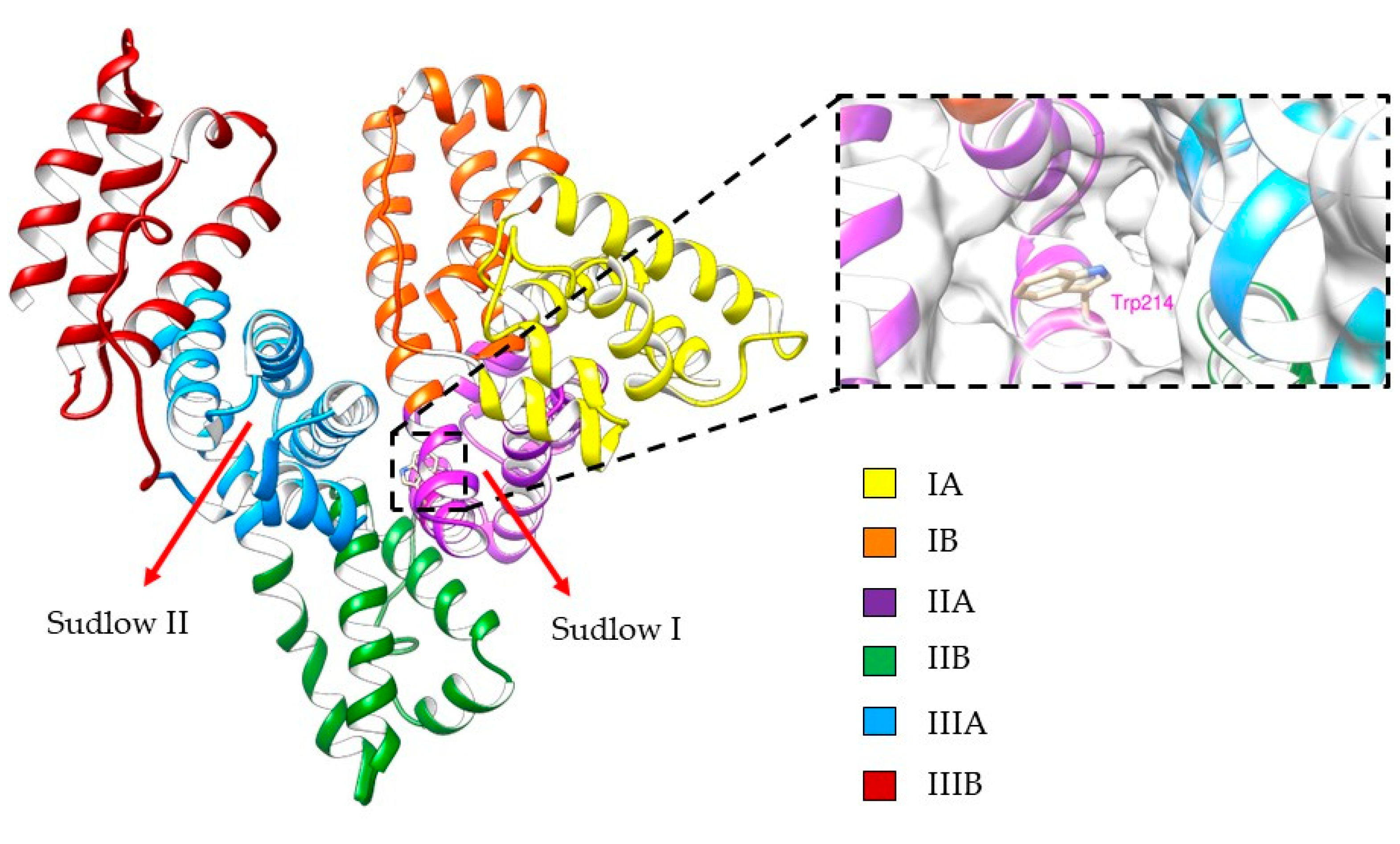
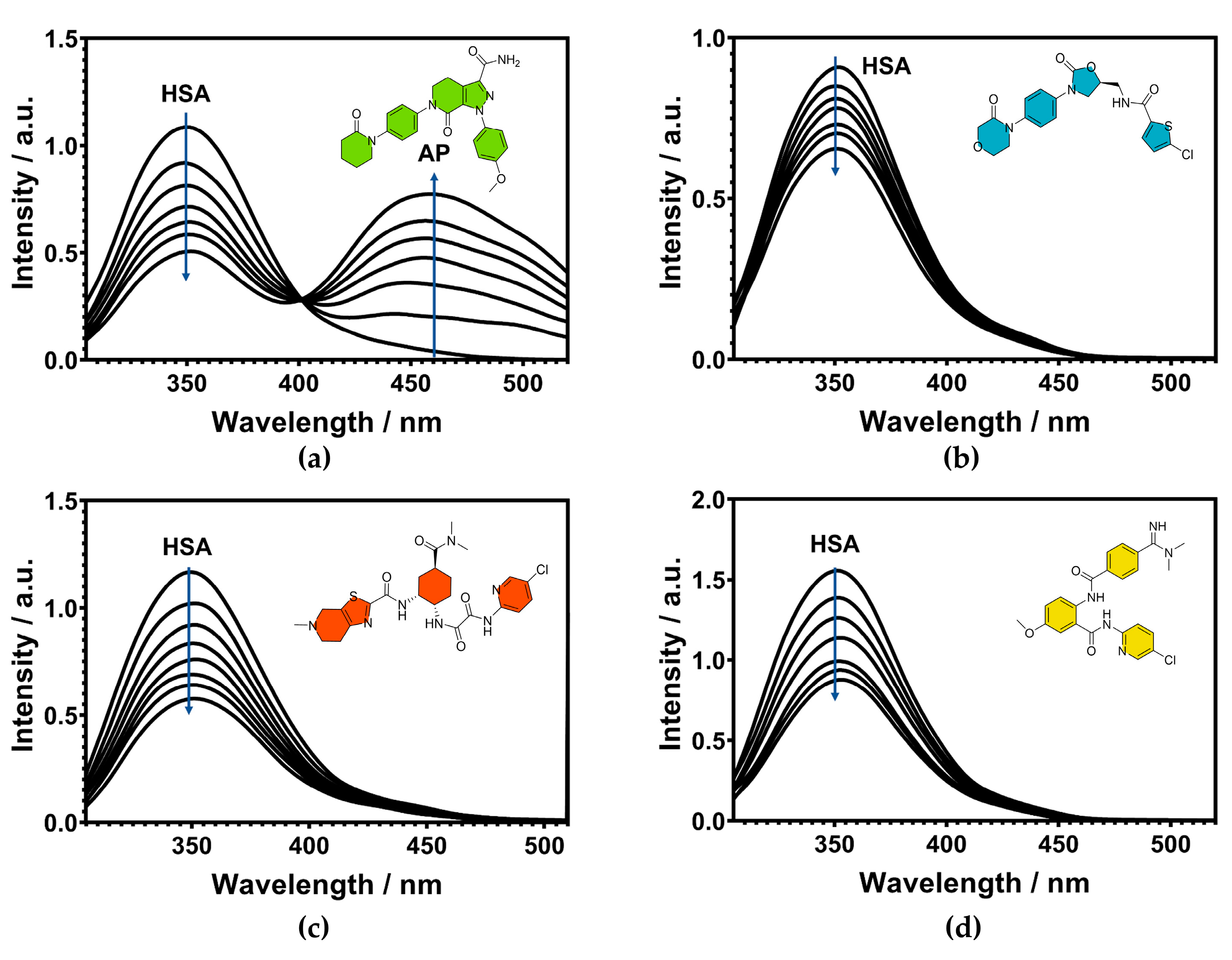
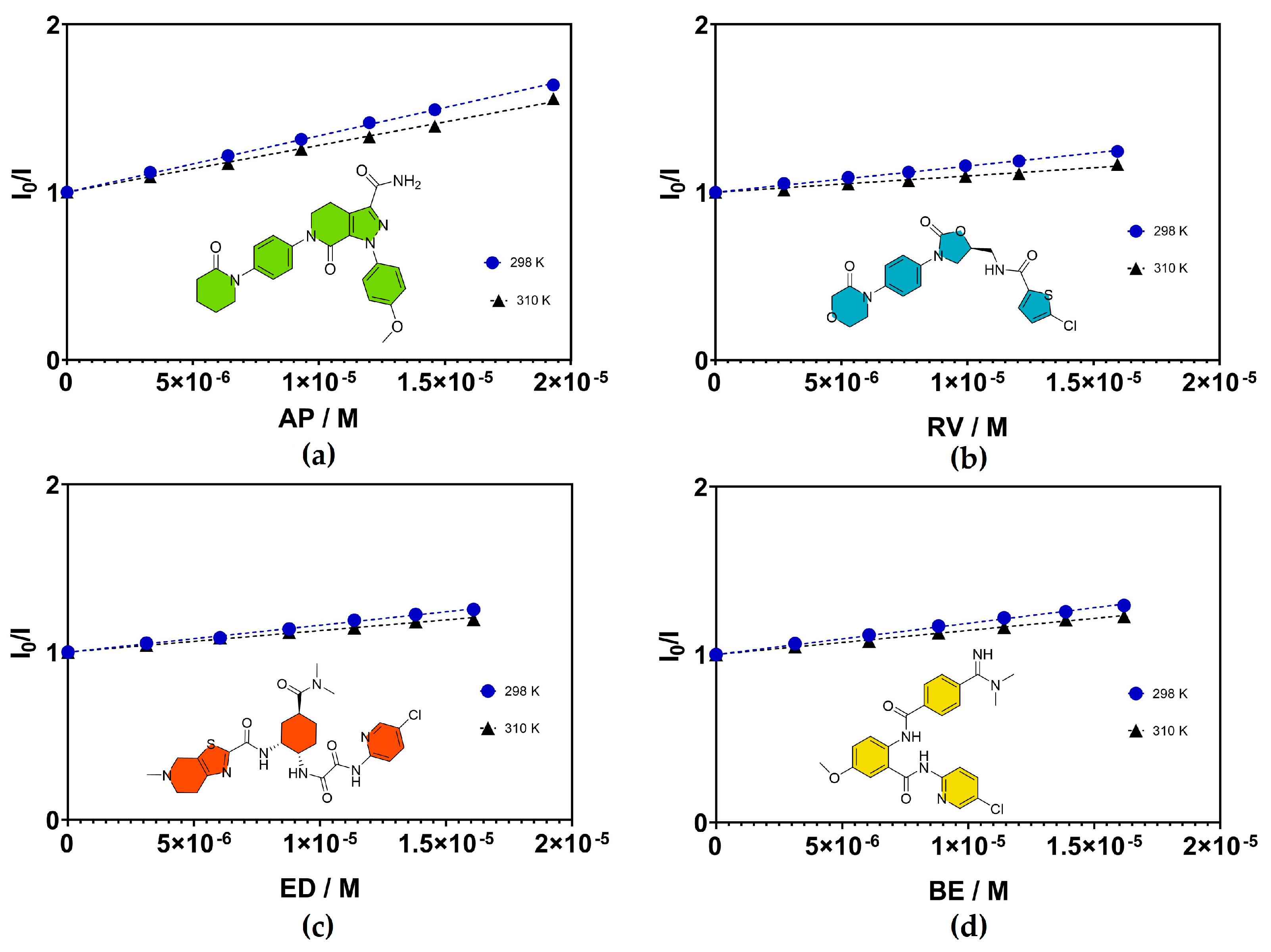

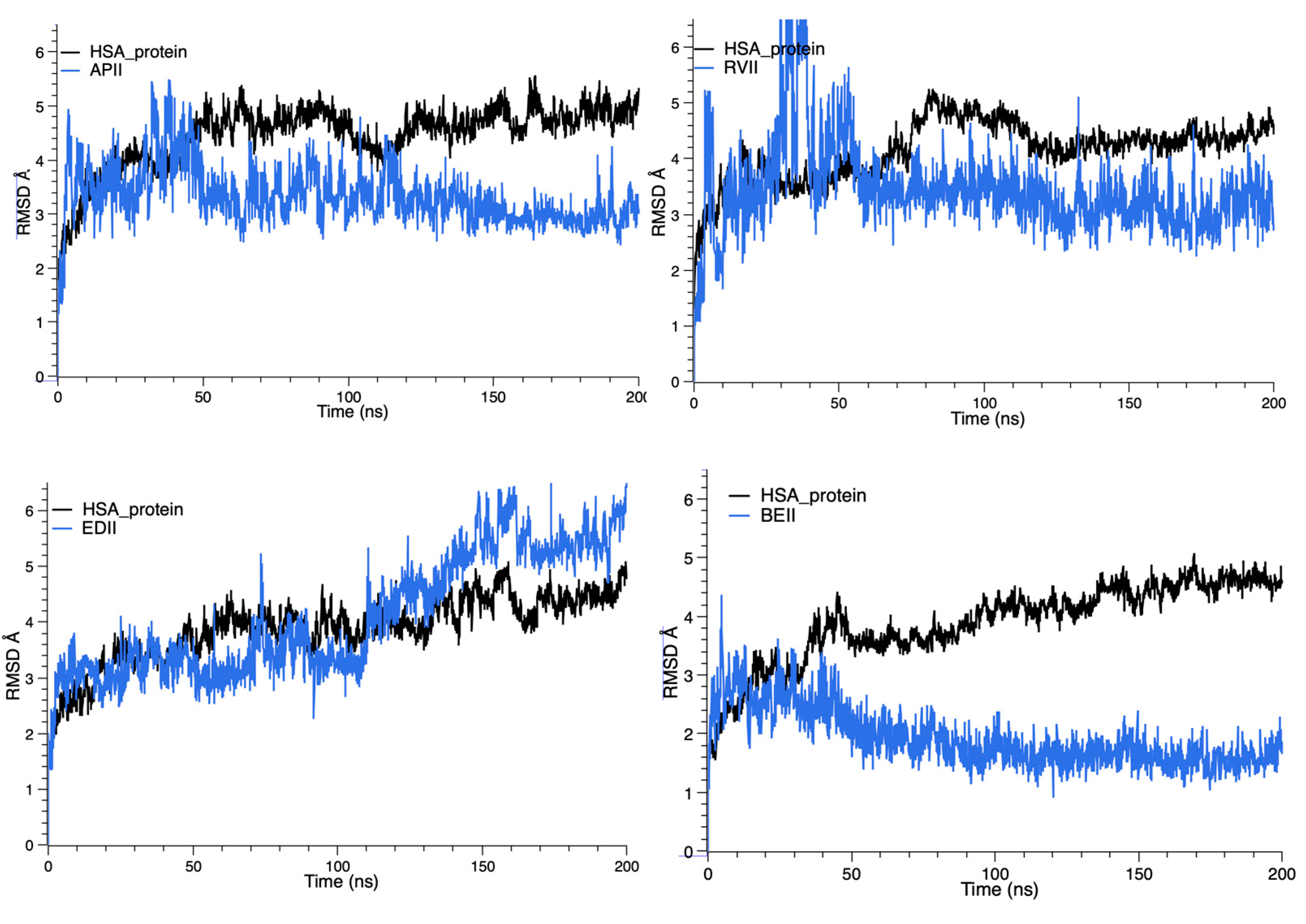
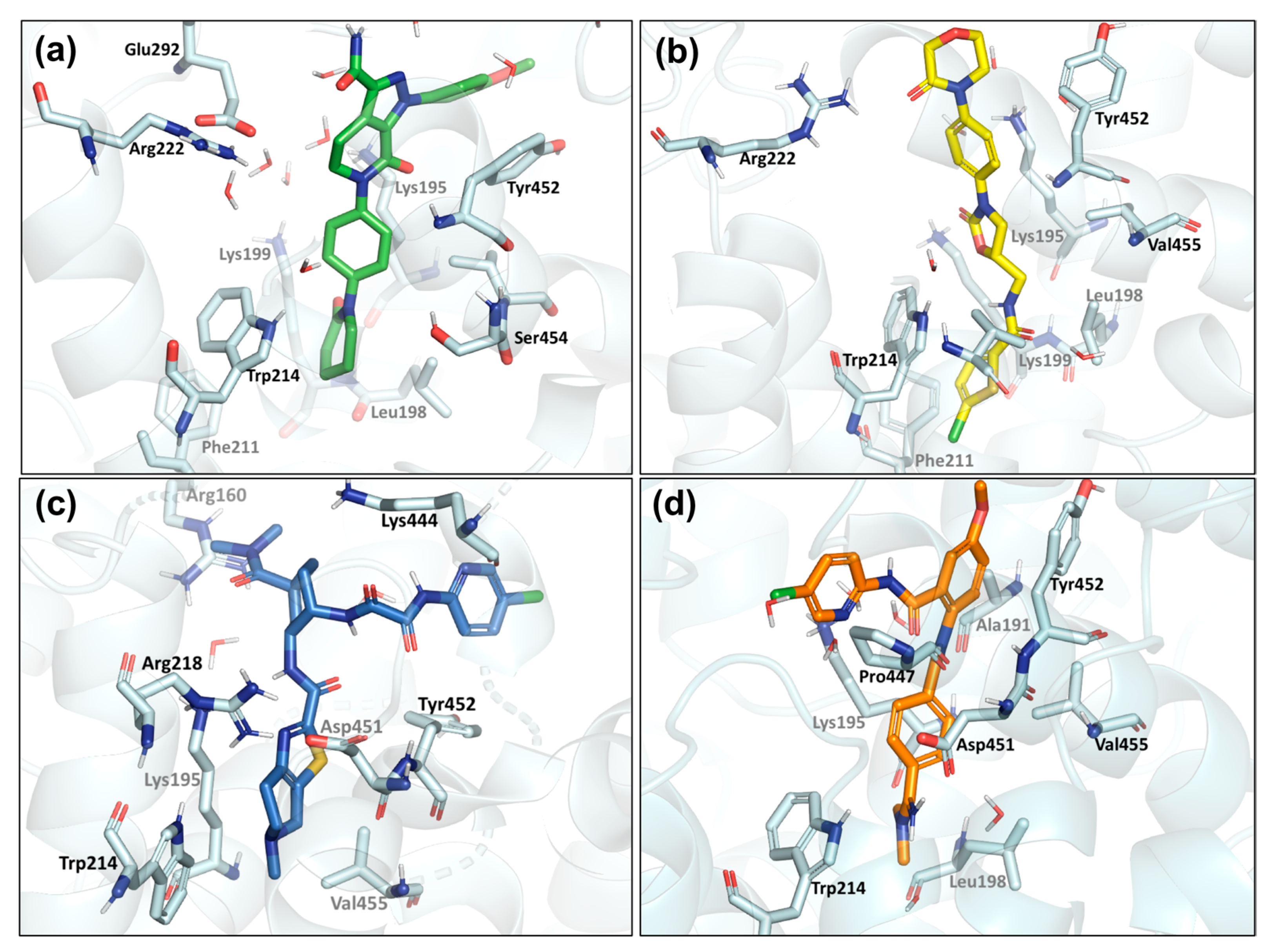
| Anticoagulant | Ksv (×104 M−1) 298 K | Ksv (×104 M−1) 310 K |
|---|---|---|
| AP | 3.36 ± 0.03 | 2.79 ± 0.02 |
| RV | 1.56 ± 0.03 | 0.98 ± 0.04 |
| ED | 1.60 ± 0.04 | 1.28 ± 0.05 |
| BE | 1.86 ± 0.03 | 1.44 ± 0.04 |
| Complex | τ1 (ns) | A1 | τ2 (ns) | A2 | χ2 | <τF> |
|---|---|---|---|---|---|---|
| AP@HSA | 3.22 | 0.45 | 7.01 | 0.55 | 1.10 | 5.30 |
| RV@HSA | 3.00 | 0.40 | 6.80 | 0.60 | 1.13 | 5.28 |
| ED@HSA | 2.99 | 0.39 | 6.80 | 0.61 | 1.13 | 5.31 |
| BE@HSA | 3.03 | 0.39 | 6.78 | 0.61 | 1.10 | 5.32 |
| Complex | KITC (M−1) | ΔH (kcal mol−1) | −TΔS (kcal mol−1) | ΔG (kcal mol−1) |
|---|---|---|---|---|
| AP@HSA | 5.56 × 103 | 6.21 | −11.33 | −5.11 |
| BEM@HSA | 1.60 × 103 | −3.22 | −1.14 | −4.37 |
| Complex | ΔEVdW | ΔEcoul | ΔElipo | ΔGGB [a] |
|---|---|---|---|---|
| AP@HSA | −63.57 ± 3.77 | −22.47 ± 4.38 | −23.40 ± 1.61 | −72.36 ± 4.43 |
| RV@HSA | −60.35 ± 3.49 | −10.90 ± 3.16 | −23.87 ± 1.32 | −69.38 ± 3.59 |
| ED@HSA | −62.42 ± 3.13 | −14.99 ± 4.44 | −18.87 ± 1.52 | −61.07 ± 5.71 |
| BE@HSA | −62.15 ± 2.12 | −51.79 ± 12.41 | −21.64 ± 0.78 | −73.23 ± 4.37 |
| FXa Inhibitor | Protein | n | K (M−1) | pH | T (°C) | Buffer (Concentration or Ionic Strength) | Binding Site | Experimental Technique | Refs. |
|---|---|---|---|---|---|---|---|---|---|
| Apixaban | HSA fatty acid-free | 1.03 | 3.41 × 103 | 7.4 | 28 | Tris–HCl (0.10 M NaCl) DMSO 2% | IIA | FS | [26] |
| Apixaban | HSA fatty acid-free | 1.00 | 2.46 × 103 | 7.4 | 37 | Tris–HCl (0.10 M NaCl) DMSO 2% | IB | FS | [26] |
| Apixaban | HSA fatty acid-free | 0.97 | 1.67 × 103 | 7.4 | 45 | Tris–HCl (0.10 M NaCl) DMSO 2% | IB | FS | [26] |
| Apixaban | HSA: heme-Fe(III) | 2.78 × 106 | 7.3 | 20 | Phosphate 2.0 × 10−2 M DMSO 10% | IB | UV | [27] | |
| Rivaroxaban | BSA | 1.10 | 1.32 × 105 | 7.4 | 25 | Phosphate DMSO 0.3% | IIA | FS | [28] |
| Rivaroxaban | BSA | 0.98 | 1.82 × 104 | 7.4 | 30 | Phosphate DMSO 0.3% | IIA | FS | [28] |
| Rivaroxaban | BSA | 0.85 | 4.37 × 103 | 7.4 | 35 | Phosphate buffer DMSO 0.3% | IIA | FS | [28] |
| Rivaroxaban | HSA: heme-Fe(III) | 4.55 × 105 | 7.3 | 20 | Phosphate 2.0 × 10−2 M DMSO 10% | IB | UV | [27] | |
| Betrixaban | HSA: heme-Fe(III) | 1.61 × 106 | 7.3 | 20 | Phosphate 2.0 × 10−2 M DMSO 10% | IB | UV | [27] | |
| Edoxaban | HSA: heme-Fe(III) | 7.69 × 105 | 7.3 | 20 | Phosphate 2.0 × 10−2 M DMSO 10% | IB | UV | [27] |
Disclaimer/Publisher’s Note: The statements, opinions and data contained in all publications are solely those of the individual author(s) and contributor(s) and not of MDPI and/or the editor(s). MDPI and/or the editor(s) disclaim responsibility for any injury to people or property resulting from any ideas, methods, instructions or products referred to in the content. |
© 2023 by the authors. Licensee MDPI, Basel, Switzerland. This article is an open access article distributed under the terms and conditions of the Creative Commons Attribution (CC BY) license (https://creativecommons.org/licenses/by/4.0/).
Share and Cite
Mariño-Ocampo, N.; Rodríguez, D.F.; Guerra Díaz, D.; Zúñiga-Núñez, D.; Duarte, Y.; Fuentealba, D.; Zacconi, F.C. Direct Oral FXa Inhibitors Binding to Human Serum Albumin: Spectroscopic, Calorimetric, and Computational Studies. Int. J. Mol. Sci. 2023, 24, 4900. https://doi.org/10.3390/ijms24054900
Mariño-Ocampo N, Rodríguez DF, Guerra Díaz D, Zúñiga-Núñez D, Duarte Y, Fuentealba D, Zacconi FC. Direct Oral FXa Inhibitors Binding to Human Serum Albumin: Spectroscopic, Calorimetric, and Computational Studies. International Journal of Molecular Sciences. 2023; 24(5):4900. https://doi.org/10.3390/ijms24054900
Chicago/Turabian StyleMariño-Ocampo, Nory, Diego F. Rodríguez, Daniel Guerra Díaz, Daniel Zúñiga-Núñez, Yorley Duarte, Denis Fuentealba, and Flavia C. Zacconi. 2023. "Direct Oral FXa Inhibitors Binding to Human Serum Albumin: Spectroscopic, Calorimetric, and Computational Studies" International Journal of Molecular Sciences 24, no. 5: 4900. https://doi.org/10.3390/ijms24054900
APA StyleMariño-Ocampo, N., Rodríguez, D. F., Guerra Díaz, D., Zúñiga-Núñez, D., Duarte, Y., Fuentealba, D., & Zacconi, F. C. (2023). Direct Oral FXa Inhibitors Binding to Human Serum Albumin: Spectroscopic, Calorimetric, and Computational Studies. International Journal of Molecular Sciences, 24(5), 4900. https://doi.org/10.3390/ijms24054900








